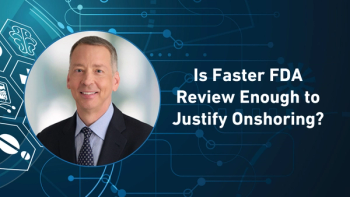
- Pharmaceutical Commerce - December 2020
- Volume 15
- Issue 4
Clues and connections from the real world
A conversation with Jane Quigley, senior VP, Digital Health, PRA Health Sciences
“Encourage your kids to be data scientists,” Jane Quigley, senior VP, digital health, at PRA Health Sciences, offered. Considered one of the “godmothers of real-world data (RWD),” Quigley was underscoring the need today—and great opportunity amid the convergence of technology and accessibility—to surface valuable business- and patient-impacting insights in areas such as clinical trial design, operational execution, regulatory and payer discussions, and asset differentiation.
“It’s about keeping up with both the information and the ability to do deep analytics on it; not just analyzing it with a spreadsheet,” notes Quigley, who leads a team of 300 people globally at PRA; her group, tapping into advanced analytics and programming languages, such as Python and R, focuses on using patient- and physician-level data to support pharma sponsors in disease modeling, RWD/real-world evidence (RWE), and drug forecasting.
“We have petabytes of data [today],” she points out. “A large size of real-world data is good, but if you can’t put context to it, then it’s not as valuable.”
Pharmaceutical Commerce caught up with Quigley recently to discuss the progress and challenges in achieving this dynamic in the life sciences and public health settings, its importance amid shifts in engagement and care delivery during the Covid-19 pandemic, and her career transition from academic medicine to the world of medical informatics.
1. What do you believe are the biggest opportunities—or where the most untapped potential exists—for biopharam companies and their CRO partners to take advantage of RWD/RWE?
I think RWE is having its moment right now, because of the virtuality and the nature of how healthcare is being delivered today. It’s not necessarily new what we’re doing, as far as it relates to things like clinical trial protocol evaluations, or informing the overall product lifecycle. But it’s about using the data, which represents in the US about 300 million people, and representing it in a regulatory-grade fashion. When you think about the information that we’ve collected traditionally in clinical trials, that data is coming directly from the same sources that a lot of the RWE data is coming from—[medical] claims data, electronic medical records (EMRs), etc.
The interesting piece in all this, is a drug is only effective if a patient takes it. And if we’re basing that safety and efficacy off of an N of, say, 150 or 180 people in an oncology trial, versus a big mega cardiovascular trial, are you having the right representation of people by age, race, gender, ethnicity?
It’s about exposing our pharma partners and biotech clients to the value that real-world data can bring to help them inform where they should actually be adjusting or pivoting.
2. Drug and vaccine trials for Covid-19 have particularly spotlighted these patient representation issues. Are there sources of RWD emerging that can glean this kind of information to aid in protocol design?
Right now, when you look at the incidence of Covid outside of nursing homes—we run a Covid tracker that updates weekly—the number of people that are non-white, who are actually dying, is almost three times that of somebody who is white. So how do we have such a huge delta and disparity there? When you start digging into the data, and layer in all of these other kind of attributes, it really gives you an identity to the rest of the world.
There’s actually a lot of new streams and sources that are coming in. We pull in quite a bit from the social and digital space. People who self-identify as white or non-white, for example, we can incorporate that data in and add it as a layer on top of the true clinical real-world data. We also layer on the census data.
One of the things that Covid has exposed is the hard truth about the health inequities that occur in the US particularly. The uninsured and underinsured populations have an outsized number of non-white people. And when you look at the mortality rates and differences [for Covid-19], it’s staggering. With these disparities in healthcare, if you aren’t incorporating in the social determinants as a major factor in how you’re guiding your R&D program, it will be difficult to enroll. That mindset needs to be there, because the setting of care has changed.
3. Overall, is the synergy between healthcare data and clinical data becoming more seamless today in helping companies make practical business decisions, such as go/no-go determinations for clinical trials?
Yes. Understanding the delivery of healthcare has probably been one of the biggest under representations in the R&D space. You had a lot of bench and traditional scientists, who were looking at one molecule to see its utility across a single target—inflammation, for example. And then it narrows down to, say, rheumatoid arthritis, and it may look like it has some of the same signaling that would be in Crohn’s [disease], for example.
But when you think about that molecule now, when you understand how healthcare is transacted—and that would be claims data and how it’s billed and paid for—the molecule has to incorporate all those value-based care elements. We’ve always installed metrics within the trial itself for pure clinical outcome, but you have to incorporate them into the overall lifecycle now, because if what you’re representing in your trial has no realistic representation in the real world, it’s going to be difficult to get off the ground.
4.With health technology assessment bodies in the US and Europe expanding their reliance on RWE, do you see this area inching more to “real-world applications”—that is in the decisions made routinely by payers to back treatments and physicians to prescribe them?
Yes and no. Europe has always placed a great deal of value on RWE, due to the nature of a nationalized healthcare. If you have two very expensive medicines—monoclonal antibodies, for example—they’re going to go with the one that has the best price that they can achieve, and the one that’s going to get consistent outcomes.
Here in the States, because we have a different healthcare delivery system, if you have two similar agents that are both exerting basically the same effect—a good example is the tyrosine kinase inhibitors in CML (chronic myelogenous leukemia); when the first landmark drug was launched, it became one of the first billion-dollar products in oncology, but then similar treatments came out—then the payers could suggest the first-line on the second-generation drug because there is enough evidence to support it, and likely receive a better price for it.
RWE is here today as it relates to the commercial use, but can be stronger as it relates to the R&D. That’s due, I believe, to the underlying nature still in our drug development process, our molecule-to-market—and that a lot of agents may be in the lab for five to 10 years before they ever get to a trial patient.
5. How has RWE influenced the decisions of payers and drug pricing watchdogs when assessing the gene and cell therapies that have emerged in recent years? Is there too little of that type of real-world and observational data available yet to apply substantial insights?
That’s actually one of the best scenarios to use the real-world data—these heavy-hitting CAR-T and other immunotherapies. In fact, in a clinical trial for a pediatric B-cell acute lymphoblastic leukemia treatment, the control arm—the observational arm—was real-world data. A rare disease and a very rare population, they knew they couldn’t do a placebo-controlled trial. So they used an external control arm just using the real-world data.
For gene therapies especially, people are getting treated with them as a child. It’s about being able to longitudinally find these patients over time in the real world; where is somebody if they got treated at age 7 and in 15 years, they’ll be 22? That RWE mechanism to be able to look backwards in time to find these patients and reach out to their current physician to get a patient-reported outcome, is critical. And it’s also a regulatory requirement.
6. Does the need remain to educate payers more about these types of data sources to increase their comfort in using them in coverage determinations?
Payers have always had a great deal of value of what the real-world data is bringing to them. But, typically, they couldn’t compare themselves to other insurers. So by democratizing real-world data, payers can get a better sense of where they fall; what did their patient populations look like, for example? They can get a better understanding of the behaviors of the folks that are in their enrollment.
They’ve always had tons of actuaries and data scientists. What they’ve had to do is groom them to ask some different questions. It’s shifting away from the pricing and utilization review sorts of metrics to more toward, “what are our patients looking like? How often are people going to the physician or the nurse practitioner? Do you have a subpopulation that’s driving x-percent of your costs? If so, why?” That’s when you start getting into the use of disease management programs and similar things to help people better manage their healthcare journey.
7. Are there still system constraints, at times, for payers in collecting and acting on RWE from sources such as claims and EMRs?
The thing about an electronic medical record is that no data field is mandatory. With claims data, every data field is mandatory. Because what is it answering? One, claims data, is answering the finances and what the patient was billed for and what the physician billed for the nurse practitioner, etc. The other one, EMR, is more clinical, whether it’s laboratory, tumor staging, or more about the phenotype of that patient.
The marriage of them both is really your richest source, and that ability to link multiple different data sources. Whether it’s opt-ins plus disease registries, for example. Tying those all together gives you that full picture of the patient, and it can typically give it to you longitudinally over time.
8. With significant disruptions to clinical trials due to Covid, how has RWE helped keep some development projects on track?
We’ve been tracking Covid from day one. We’re providing that data to both pharma and government clients to be a good corporate steward. But the other piece to it is we’re trying to use that data to better understand the disease. We know some people with Covid can get very sick, very quickly. So if we can create a group of people that we know have tested positive, but aren’t requiring hospitalization, and thus ventilation, we can use them as a control arm.
Then what we’ve been doing is pulling them forward in time to uncover things like their time to recovery—what did they need after that? Did they go on steroid drugs or not? So by mining the data we have from the real world, especially from the first wave of the virus, we’ve been able to model a lot of clinical trials in relation.
9. For Covid-specific trials or studies in general?
Actually for everything. It’s really about turning all the levers on. With Covid, it was impacting enrollment across all our trials, because the clinics were closed. People were still going into, for example, the oncologist office to get their chemotherapy. But the whole nature of the visit changed. You went in, you were spaced apart, your time changed, everyone with a mask, gloves. There was never an opportunity for a physician to say, would you
be interested in a clinical trial? We had to look at all of that data as it related to Covid impacting the entire healthcare space, not just people diagnosed with the virus. People weren’t going to the doctor, so all of those were missed opportunities for any sort of discussion about a trial enrollment. And we also had to pivot on things like, what does that conversation look like in a remote visit?
We’ve had to be really creative, because you have to access people in a completely different fashion now; that’s why we’ve exploring looking at in-home assistance, for example.
And, most importantly, you need to have all of the appropriate mechanisms in place around privacy, security, and compliance. If you don’t, as it relates to people receiving care traditionally in the clinic, you’re years behind. You need to have the tools to be able to both digest and ingest information as it’s coming in, in real time.
10. You began your career actually in academic medicine, and were formerly the clinical nurse specialist for hematology-oncology at Georgetown Lombardi Comprehensive Cancer Center, where you also directed the bone marrow transplantation program. What drove your switch to the data insights and analytics side?
At Georgetown, we had a very small number of people coming into the clinic that were on a trial; everybody else wasn’t on a trial, but we weren’t collecting data. At the time, I was working with a postdoc, and I said, “let’s create a database.” Sure enough, mining through that data, it actually helped to support a client’s safety initiative. So I kind of evolved into the data and technology and consulting space.
I went on to create a company that did disease management, and established an oncology program. We sold that to Optum. I was part of the team with [IntrinsiQ LLC, later acquired by AmerisourceBergen] that created the first oncology EMR [in collaboration with GE Healthcare]. Then I got into the heavy-hitting analytics and patient-level data, first with a company (SDI) that would be sold to IMS Health (where Quigley would spend three years before joining PRA in 2014).
If I stayed in academic medicine, I would see probably 700 or a thousand patients a year. Right now, I see 300 million people in the US every day.
Articles in this issue
almost 5 years ago
Advanced analytics: Powering pharma’s most critical data missionalmost 5 years ago
Next-gen AI: Widespread adoption hinges on trustalmost 5 years ago
Worthy of further analysisalmost 5 years ago
Elevating brand outreach in the age of Covidalmost 5 years ago
AI ‘voice’ grows louder in 2020almost 5 years ago
Effective and proactive oversight of master dataalmost 5 years ago
Data as a strategic asset in the life sciencesNewsletter
Stay ahead in the life sciences industry with Pharmaceutical Commerce, the latest news, trends, and strategies in drug distribution, commercialization, and market access.




